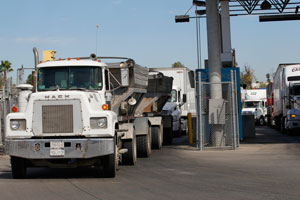US Opening Border to Mexican Truckers

DOT will publish a notice in the Federal Register, probably Jan. 15, saying Mexican carriers are allowed to apply for operating authority here, ending more than 20 years of dispute over the Mexican truck issue.
“The policy change is expected to result in the permanent termination of more than $2 billion in annual retaliatory tariffs on U.S. goods and follows a three-year pilot program that tested and validated the safety of Mexican trucking companies to operate longhaul in the U.S,” the DOT announcement said.
Transportation Secretary Anthony Foxx said opening the border to “a safe cross-border trucking system with Mexico is a major step forward in strengthening our relationship with the nation’s third largest trading partner, and in meeting our obligations under [the North American Free Trade Agreement].
“Data from the three-year pilot program, and additional analysis on almost 1,000 other Mexican longhaul trucking companies that transport goods into the United States, proved that Mexican carriers demonstrate a level of safety at least as high as their American and Canadian counterparts,” Foxx said.
MORE FROM FOXX: Comfortable with decision
American Trucking Associations said it supports a border-trucking policy that allows foreign motor carriers that want to operate in the United States, as long as they comply with the regulatory and financial requirements that apply to U.S. carriers.
“Nothing less is acceptable to ATA,” the federation said in a statement that noted that trucks transport more than 65% of the value of all U.S.-Mexico surface trade.
“ATA is committed to working with DOT, as well as other federal, state and local government agencies, as well as their Mexican counterparts, to improve cross-border operational efficiencies, processes and systems and to facilitate the movement of lawful trade across our mutual border while respecting and complying with national operational requirements.”
Immediate objections were raised, however, by another sector in the trucking industry, the Owner-Operator Independent Drivers Association.
“The FMCSA is clearly doing an end-around and playing with numbers to try and justify opening the border to longhaul trucks from Mexico,” OOIDA Executive Vice President Todd Spencer said.
“It’s clear from the lack of participation that Mexico-based motor carriers are not interested [in] hauling beyond the commercial zone, if it means complying with the same regulations that U.S. truckers do,” he said in a statement.
Only 15 Mexican carriers participated in a three-year pilot program run by the Federal Motor Carrier Safety. The program ended in October.
“FMCSA’s persistence to move this program forward is mind-boggling, especially when the agency tells us ad nauseam that their highest priority is safety. Yet this program is all about geopolitical economics,” Spencer said.
U.S. Trade Representative Michael Froman welcomed the news, the DOT statement said.
“The successful conclusion of the pilot program provides the basis for the permanent resolution to this dispute,” Ambassador Froman said.
“We have been, and will continue to work with Mexico to ensure that the threat of retaliatory duties will now be brought to a swift conclusion as well,” he said. “Formally concluding this process will help us continue our work to expand trade and investment opportunities between our countries.”
A report released by the DOT’s Inspector General last month said that with only 15 carriers, which dropped to 13 by the end of the pilot, the IG could not draw conclusions about whether the general population of Mexican trucks would have the same high safety standards as those that participated in the pilot.
However, the same day DOT announced the border was being opened to Mexican trucks, the Federal Motor Carrier Safety Administration sent its own report to Congress.
The FMCSA report said the pilot results show that Mexican carriers “can and do operate throughout the United States at a safety level equivalent to U.S- and Canada-domiciled motor carriers and consistent with the high safety standards that FMCSA imposes on all motor carriers authorized to operate in the United States.”
The conflicting reports are likely to draw the attention of Congress, which before the pilot was launched, had blocked other attempts to let Mexican trucks run longhaul beyond designated commercial zones at the border.
The dispute over the border opening dates to 1994, when Nafta took effect. The United States was to open its borders to more longhaul Mexican trucks, but the opening was delayed by questions from the Teamsters and others about safety standards.
DOT noted that in 2001, a Nafta dispute settlement panel said the United States was not in compliance with the cross-border trucking provisions of the agreement.
And in 2009, Congress used its appropriations power to halt a demonstration project, at which point Mexico “exercised its option to take retaliatory measures, granted by a Nafta arbitration panel, and impose more than $2 billion in annual tariffs on exports of U.S. agriculture, personal care products and manufacturing goods.”
Mexico “suspended” the tariffs after the new pilot program began in 2011.
Mexican carriers seeking longhaul operating authority will be required to pass “a pre-authorization safety audit to confirm they have adequate safety management programs in place, including systems for monitoring hours of service and to conduct drug testing” using labs certified by the U.S. Department of Health and Human Services.
“Additionally, all drivers must possess a valid U.S. Commercial Driver’s License or a Mexican Licencia Federal de Conductor, and must meet the agency’s English-language proficiency requirements,” DOT said.




